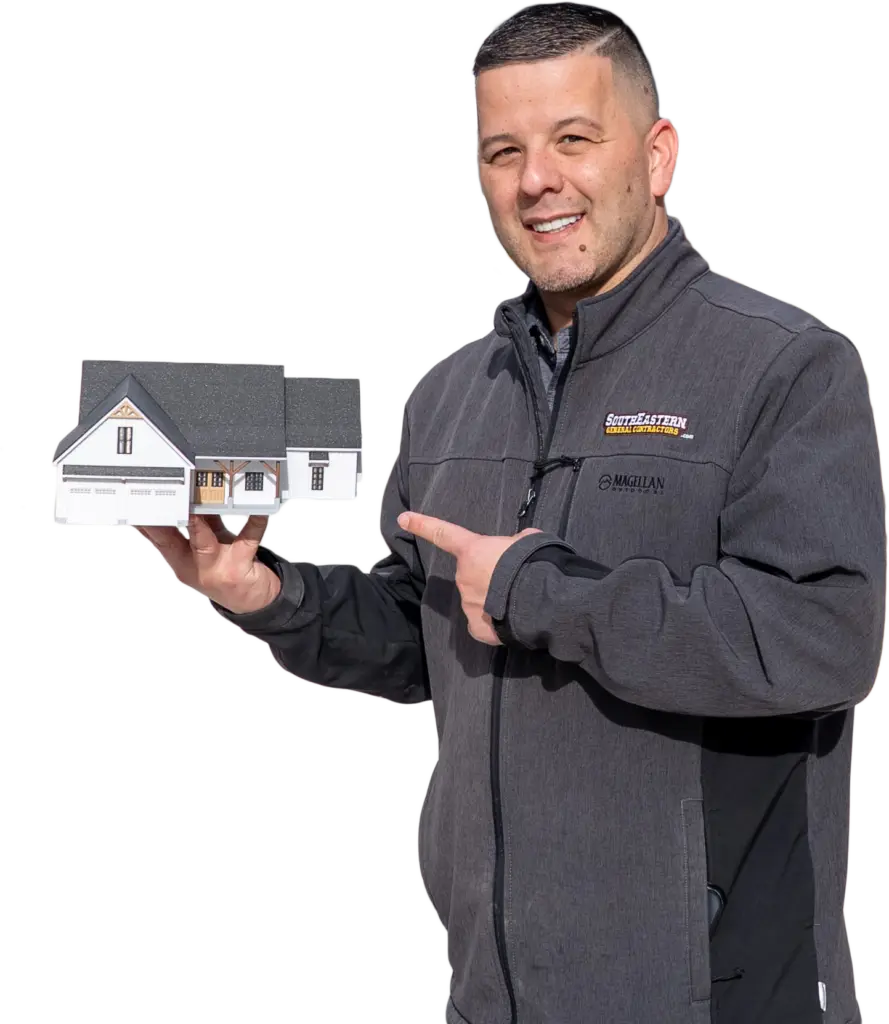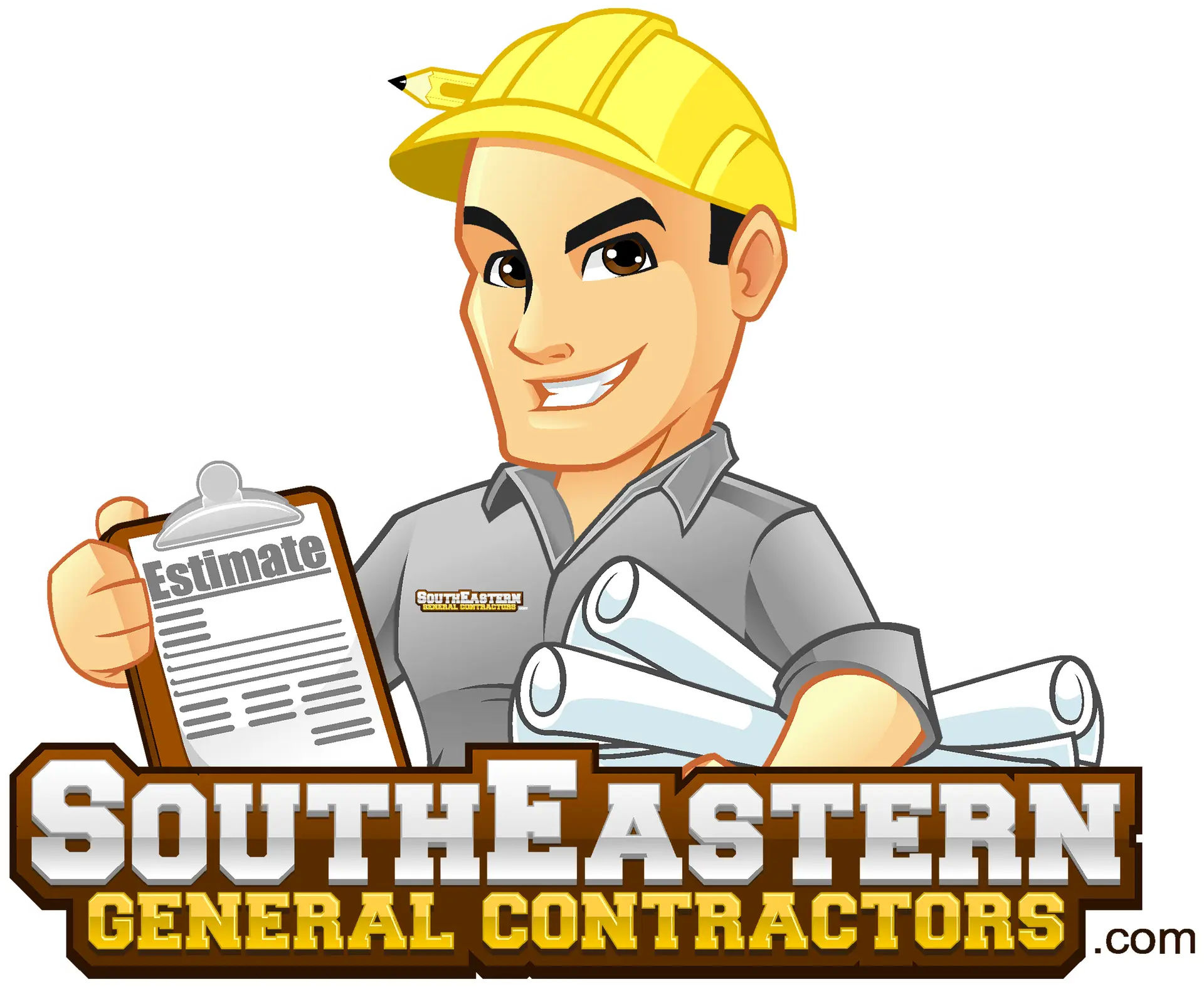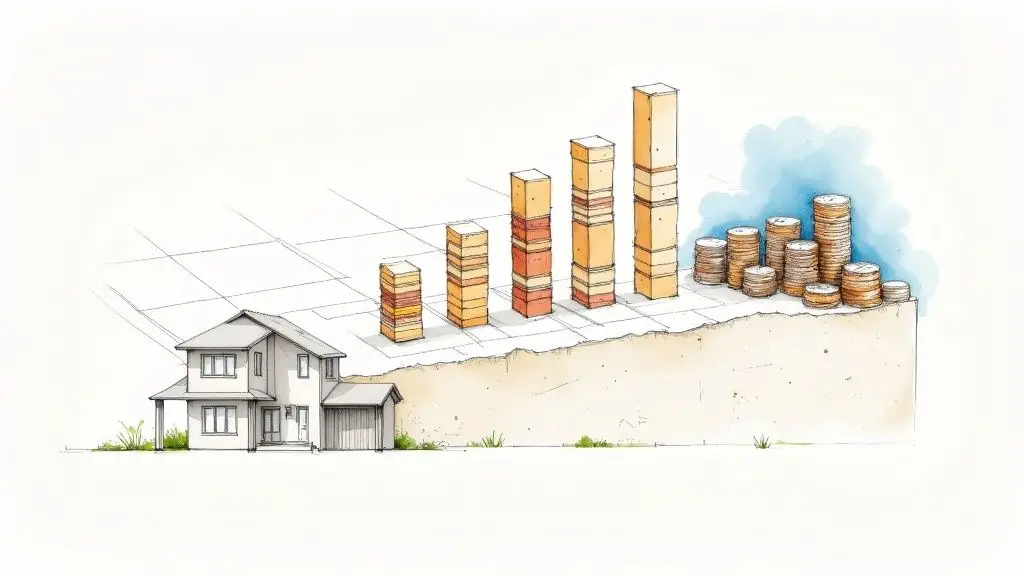
Understanding Custom Home Builder Cost: A Guide to Your Investment
When you start thinking about building a custom home, the first question on your mind is almost always, "What's this actually going to cost me?" It's the starting point for the entire journey. On a national level, you'll see figures ranging from $200 per square foot for a home with practical finishes to over $550 per square foot for true high-end luxury.
But let's be honest—those numbers are just a ballpark. The real story is in the details, and the true value comes from partnering with a builder who can turn that budget into a home that lasts a lifetime. As a local leader in Fayetteville and Lumberton for over 21 years, our goal is to educate and empower you, ensuring your investment builds a legacy, not just a structure.
The Real Cost of Building Your Custom Home
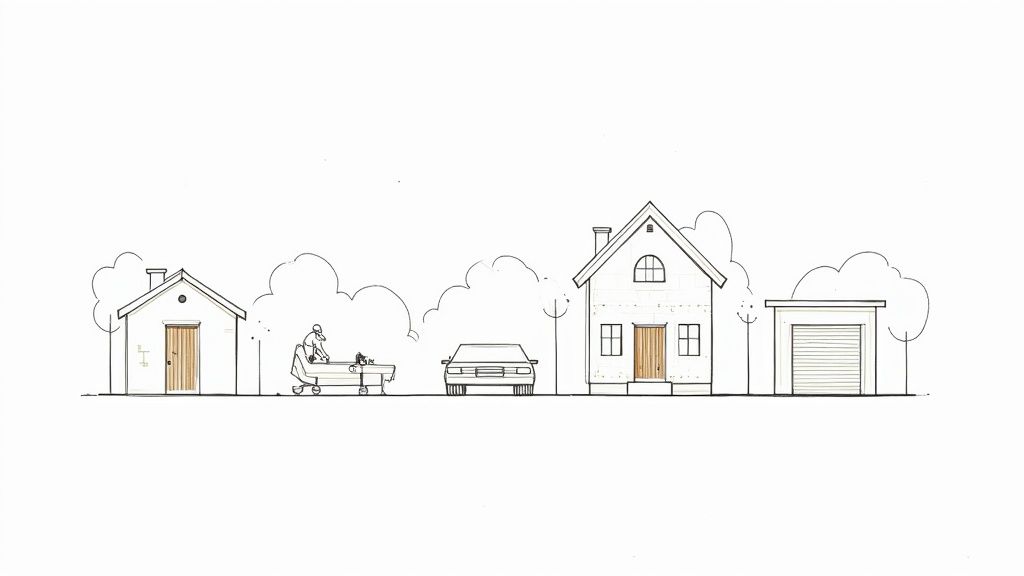
Building a home from the ground up is easily one of the most significant and rewarding investments you'll ever make. It’s far more than a simple transaction; it's about crafting a space that’s a perfect reflection of your family, your lifestyle, and your future. Here at South Eastern General Contractors (SEGC), we know that the conversation about cost is the foundation of your entire project, built on client trust and quality.
To give you a clearer picture, let's look at some numbers for context. National data from sources like HomeAdvisor suggests the average cost to build a custom home hovers around $825,000, with most projects landing somewhere between $300,000 and $1.2 million.
This massive range comes down to a few key things: the size of the home, its location, the complexity of the design, and the finishes you choose. Labor alone often accounts for 40% to 50% of the total budget. While these national averages are a helpful starting point, it’s the local, on-the-ground expertise that really shapes your final investment.
Here's a quick look at how those numbers break down based on different levels of finishes and home sizes.
Custom Home Cost at a Glance Based on National Averages
| Category | Low-End (Basic Finishes) | Mid-Range (Quality Finishes) | High-End (Luxury Finishes) |
|---|---|---|---|
| Cost Per Square Foot | $150 – $250 | $250 – $400 | $400 – $550+ |
| 2,000 sq ft Home | $300,000 – $500,000 | $500,000 – $800,000 | $800,000 – $1.1M+ |
| 3,000 sq ft Home | $450,000 – $750,000 | $750,000 – $1.2M | $1.2M – $1.65M+ |
| 4,000 sq ft Home | $600,000 – $1M | $1M – $1.6M | $1.6M – $2.2M+ |
This table gives you a solid framework, but remember that every detail, from the type of flooring to the brand of faucets, will move the needle.
Translating Numbers into Lasting Value
For over 21 years, we’ve been sitting down with families in communities like Fayetteville and Lumberton, walking them through this very process with clarity and confidence. We genuinely believe that a transparent, well-planned budget is the bedrock of a successful build. Our promise is to give you a complete, honest picture of the investment required, so there are no surprises down the road.
At SEGC, we believe in building legacies, not just structures. This means every dollar is accounted for, every choice is intentional, and the final product is a home built on a foundation of quality and trust.
We bring a unique level of accountability to the table, backed by credentials that speak to our high standards and deep roots in the community:
- Native American-owned: Reflecting our deep commitment to integrity and our local heritage.
- SBA 8(a) Certified: A mark of proven performance and business excellence recognized at a federal level.
- HUBZone Certified: Highlighting our dedication to fostering economic growth right here in our local areas.
Your Vision and Your Budget
Your vision for your home is entirely unique, and your budget should be built to match. Maybe you're dreaming of a practical, durable home for a growing family, or perhaps you're envisioning a luxury retreat with all the high-end features. The key is understanding exactly how each of your choices impacts the bottom line.
This guide is designed to do just that—to empower you with knowledge. We'll break down the major cost drivers, from lumber and labor to those often-overlooked expenses, giving you actionable insights every step of the way. Our mission is to ensure your investment creates a home that not only meets your needs today but stands as a proud testament to quality for generations to come. Let's start building your legacy, together.
What Actually Drives Your Home Building Cost?

Knowing the average price per square foot is a helpful starting point, but to really get a handle on your custom home builder cost, you need to dig into what makes up that number. The final price isn't just one big, mysterious figure. It’s really the sum of a few key components, each with its own moving parts.
Think of it like a three-legged stool: Land, Materials, and Labor. If one leg is much longer or shorter than the others, the whole thing gets wobbly. At SEGC, our job is to help you build a sturdy, balanced budget by understanding each leg inside and out.
When you know where the money is going, you can make smarter trade-offs and ensure every dollar is invested wisely to build the home you've always envisioned.
The Foundation: Land and Site Prep
Long before a single wall goes up, the land itself has a huge say in your final budget. The purchase price of the lot is just the beginning. The real variable is site work—the cost of preparing that specific piece of ground for construction.
Here in communities like Fayetteville and Lumberton, the land can change dramatically from one plot to the next. A perfectly flat, clear lot is straightforward. But a sloped, wooded, or rocky parcel? That requires a lot more work.
Key site preparation costs usually include:
- Clearing and Grading: This involves removing trees, rocks, and any other debris, then leveling the ground to create a stable pad for your home's foundation.
- Excavation: You have to dig, whether it’s for a foundation, a full basement, or a crawl space. The more you dig, the more it costs.
- Utility Connections: Running lines for water, sewer, electricity, and gas from the main street to your house can be surprisingly expensive, especially on more rural lots.
- Soil Testing: We need to be sure the ground can support the weight of your home without shifting or settling over time.
For example, a beautiful sloped lot in the Fayetteville area might need a more complex (and costly) foundation design and retaining walls to manage rainwater properly. This is where local experience is non-negotiable. With our 21+ years of proven results in this region, we know how to spot these potential challenges and build them into the budget from day one, so you're never caught off guard.
The Building Blocks: Materials
Materials are the most visible part of your home’s cost, and they're influenced by both your personal style and what’s happening in the market. This category covers everything from the lumber framing your house to the light fixtures in the kitchen.
The choices you make here can create the biggest swings in your budget. For instance, standard vinyl siding is a durable and budget-friendly choice. But if you upgrade to a premium brick or stone exterior, you could easily add tens of thousands to the final price. The trade-off, of course, is a huge boost in curb appeal and rock-solid durability for decades to come.
"Your builder isn't just a contractor; they are your financial steward for the project. An experienced builder protects your investment by guiding you toward materials that balance quality, aesthetics, and your budget, ensuring long-term value."
The Expertise: Labor
The final, and you could argue most critical, cost driver is labor. This is the skill, craftsmanship, and day-to-day project management that turns a pile of materials into a finished home. Investing in a highly skilled and reputable crew isn't just an expense—it's your single best insurance policy against future headaches.
A cheaper, less experienced crew might save a little money upfront, but it often leads to mistakes that require expensive fixes down the road—think leaky roofs, uneven floors, or faulty wiring. At SEGC, we see our team as the guardians of your investment. Our seasoned professionals are committed to quality and trust, ensuring every detail is executed perfectly the first time.
Recent industry data really drives this home. According to the National Association of Home Builders, construction expenses now make up 64.4% of a new home's total price. This is a significant jump, pushed by widespread inflation on materials. You can see the full details in their report on construction cost trends on NAHB.org. Now more than ever, you need a builder who can navigate these factors with experience and a solid plan.
How to Navigate Rising Material Prices
Understanding the numbers behind your custom home builder cost is a great start, but what do you do when those numbers won't sit still? The price of building materials isn't a fixed menu item; it ebbs and flows with global events, supply chain hiccups, and broad economic shifts. This volatility has become one of the biggest headaches for both homeowners and builders.
In just the last few years, the industry has been hit with a perfect storm of supply chain chaos, labor shortages, and inflation, causing building costs to jump by nearly 40%. We've all seen the wild price swings for lumber, and concrete costs have steadily climbed thanks to higher energy and transport expenses. You can dig deeper into these global construction cost trends at UGConstrucciones.com.
But here’s the good news: this new reality doesn’t mean your dream home is out of reach. It just means you need a builder who has a smart, proactive plan to handle these risks.
At SEGC, we see market uncertainty not as a roadblock, but as a challenge to be managed. With 21+ years of proven results, we’ve navigated these cycles before and know exactly how to protect our clients' budgets and timelines.
Why Local Leadership Matters More Than Ever
When national supply chains are stretched thin, a builder's local relationships suddenly become their most powerful tool. A builder with deep roots in the community isn't just another faceless account placing orders; they have real, established partnerships with the local suppliers and distributors who keep projects moving.
For our clients in Fayetteville and Lumberton, this isn't just a talking point—it delivers tangible advantages. Our long-standing connections mean we can often get our hands on materials when others are told to wait, and we’re in a much better position to secure stable pricing. We've spent over two decades building trust with these local businesses. That's a foundation of loyalty you simply can't create overnight, and it’s a huge part of how we keep your project on solid ground.
This image really drives home how building costs can differ by region, showing why the South is often a more cost-effective place to build.

As you can see, our home base in the South, including North Carolina, gives our clients a head start with a more favorable cost environment compared to many other parts of the country.
Strategic Planning for Price Volatility
Getting ahead of rising material costs takes more than just good relationships. It requires a forward-thinking strategy built on experience. Here’s a look at how we stay one step ahead for our clients:
- Early Material Procurement: The moment your design is finalized, we get to work. We don't wait for prices to creep up. We lock in quotes and order critical materials—like framing packages, windows, and trusses—as early as possible to shield you from future increases.
- Flexible Material Selection: What if a specific product suddenly doubles in price or gets stuck on a cargo ship for months? We tap into our deep product knowledge to find high-quality, cost-effective alternatives that preserve the look, feel, and durability of your home.
- Transparent Communication: We operate on a foundation of total transparency. If an unexpected price change happens, you won't be the last to know—you'll be the first. We'll lay out the issue, explain the options clearly, and empower you to make an informed decision that works for your budget.
At SEGC, our commitment to client trust means we anticipate challenges before they become problems. As a Native American-owned, 8(a), and HUBZone certified firm, we operate with a level of integrity and accountability that ensures we are always acting in your best interest.
The table below breaks down some of the biggest material cost factors and shows how our hands-on approach helps keep them in check.
Key Material Cost Drivers and Our Mitigation Strategies
| Material | Primary Cost Factor | SEGC's Mitigation Strategy |
|---|---|---|
| Lumber | Supply/demand fluctuations, tariffs, and transportation costs. | We leverage our strong relationships with local lumberyards to secure bulk pricing and place early orders, locking in rates before market spikes. |
| Concrete | Rising energy costs for production and raw material (cement) expenses. | By coordinating pours efficiently and working with trusted local concrete suppliers, we minimize waste and avoid rush charges. |
| Windows & Doors | Labor shortages at manufacturing plants and supply chain delays for components. | We order these long-lead items as soon as designs are approved, building the schedule around their delivery to prevent costly project delays. |
| Finishes (Flooring, Tile) | Trends, import logistics, and raw material availability. | We guide clients toward beautiful, durable options from reliable suppliers and are always ready with high-quality alternatives if a chosen product faces a sudden delay or price hike. |
These strategies aren't just theories; they are practical, proven methods we use every day to deliver value and certainty.
For instance, on a recent build in Fayetteville, the specified engineered hardwood flooring was suddenly hit with a multi-month backorder. Instead of letting the entire schedule grind to a halt, we immediately contacted our local flooring partner. We sourced a comparable—and frankly, slightly more durable—product that the homeowner absolutely loved, keeping the project moving forward without missing a beat.
It’s this kind of proactive problem-solving that defines the SEGC experience. By combining smart planning with our deep community ties, we help you build your legacy with confidence, no matter which way the market winds are blowing.
Uncovering the Hidden Costs of Home Building
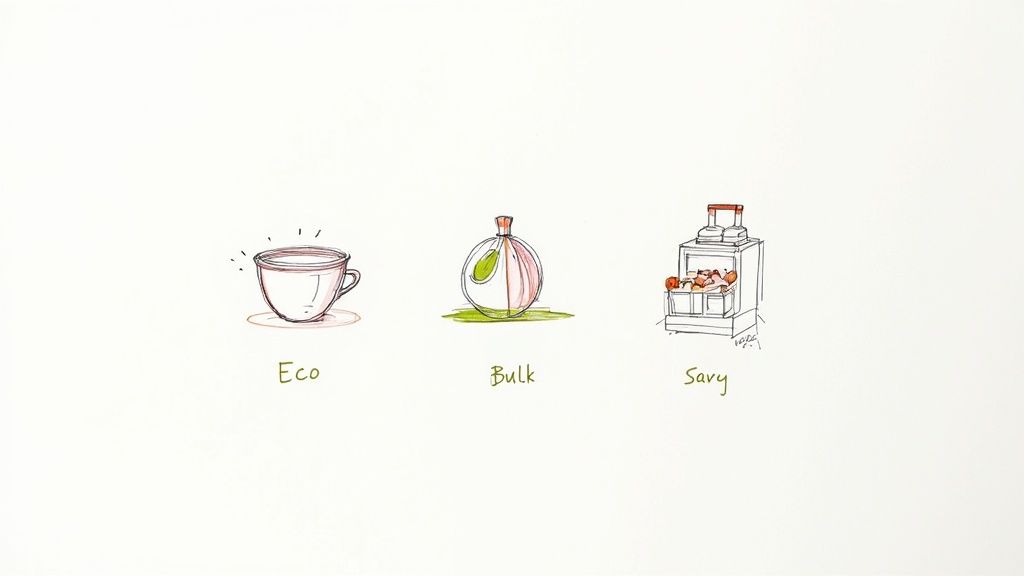
When you first start budgeting for a custom home, it's natural to focus on the tangible things—the foundation, the lumber, the beautiful finishes you've been dreaming of. But a realistic custom home builder cost goes so much deeper than what you can see. Many homeowners get blindsided by what we in the industry call "soft costs," those essential expenses that aren't part of the physical house itself.
Here at SEGC, we believe trust is built on transparency. With over 21 years of proven results, we've learned that the only way to build a lasting legacy is to eliminate surprises from the very start. We make it our job to illuminate every potential cost, giving you a complete and honest picture of the investment required to bring your dream to life.
Beyond the Build: Site Fees and Permits
Long before the first shovel hits the dirt, there’s a surprising amount of administrative groundwork to cover. These are the fees, permits, and professional services that lay the foundation for a successful build, and their costs can vary widely depending on where you're building and how complex your home is.
- Architectural and Engineering Fees: Unless you’re starting with a pre-made stock plan, you'll need a licensed architect or designer to draft your unique blueprints. Often, a structural engineer also needs to review and approve those plans, which is especially important for intricate designs or properties with challenging soil conditions.
- Building Permits: Every single municipality, from Fayetteville to Lumberton, requires a stack of permits for new construction. These fees aren't just red tape; they pay for crucial inspections at different stages of the build, ensuring your home is structurally sound and safe for your family.
- Impact Fees: In growing communities, you might also encounter impact fees. These are charged by the county or city to help offset the cost of new public infrastructure—like roads, schools, and parks—that your new home will rely on.
These upfront costs are non-negotiable and can easily add thousands to your total budget before construction even begins.
Connecting to the Grid: Utility Hookups
A house isn't a home until the lights turn on and the water flows. Connecting to public utilities seems straightforward, but it can become a major hidden expense, especially if your lot is in a rural area or a brand-new development.
For instance, we recently worked on a project just outside of Lumberton where the homesite was set back several hundred feet from the main road. The cost to dig a trench and run all the necessary electrical and water lines was a significant but unavoidable line item. An experienced builder sees this coming and bakes it into the initial estimate, so it isn't a shock later on.
"A builder’s job is to see the whole picture, not just the house itself. Our process is built on a foundation of trust and transparency, which means accounting for every cost—from the blueprints to the final landscaping—so our clients can budget with total confidence."
The Final Touches: Landscaping and Outdoor Spaces
Your budget shouldn't stop at the backdoor. A brand-new house sitting on a patch of bare dirt just feels unfinished. Landscaping is one of the most commonly overlooked budget items, yet it’s absolutely essential for curb appeal and for creating a home that truly feels complete.
Think about these common outdoor expenses:
- Grading and Sod: You need proper grading to ensure rainwater flows away from your foundation, and laying fresh sod is the fastest way to get a lush, green lawn.
- Driveways and Walkways: Whether you envision simple concrete, stylish pavers, or classic gravel, you need a way to get from the street to your front door. This is a must-have expense.
- Fencing and Decks: A privacy fence, a welcoming patio, or a spacious deck can dramatically expand your living space, but they all come with their own material and labor costs.
The Most Important "Hidden" Cost: Your Contingency Fund
Here’s a piece of advice from someone who's seen it all: no matter how perfectly you plan, something unexpected will happen. That's why a contingency fund is the single most important "hidden cost" to budget for. This is a dedicated portion of your budget—we recommend 10-15% of the total construction cost—set aside purely for surprises.
This fund is your safety net. It could cover the cost of hitting solid rock during excavation, a sudden price hike on your preferred flooring, or a weather delay. Having it in place prevents stressful, last-minute decisions and keeps your project financially healthy. It's a cornerstone of responsible budgeting and a non-negotiable part of how we guide our clients. To learn more about getting prepared, you can read about some of the most common mistakes to avoid when building a custom home.
How to Create a Budget That Builds Your Legacy
Alright, let's talk about the part of the process where you take control: budgeting for your custom home. This is where the dream starts to feel real. A solid budget isn't just about numbers on a spreadsheet; it's your personal roadmap, making sure the custom home builder cost doesn't spin out of control.
Think of it as the bridge between the home you’ve imagined and the one you can realistically build. It’s all about making smart choices that you’ll be happy with on move-in day and for years to come, without giving up the things that truly matter to you.
Start with a Clear Vision and Priorities
If there’s one mistake I see people make over and over, it’s jumping into design without first figuring out how they actually want to live in their new home. A Pinterest board full of pretty pictures is a great starting point, but a real budget needs more than that. Before you even look at a floor plan, sit down and get clear on your priorities.
This is about separating your "must-haves" from your "nice-to-haves." Is that gourmet kitchen with a six-burner range an absolute deal-breaker? Or would you rather have a finished basement for the kids to take over, even if it means using standard tile in the guest bathroom?
"The most successful projects we've built in Fayetteville and Lumberton started with families who knew their priorities inside and out. When you know what's truly important, every budget decision becomes simpler and more intentional."
– SEGC Project Manager
When you have this list, you can put your money where it will make the biggest difference in your day-to-day life. That's how you go from just building a house to creating a home that’s a perfect fit for your family.
Practical Strategies for Smart Savings
Saving money doesn't have to mean cutting corners or settling for less. It’s about being smart. Here are a few proven ways we help our clients get the most out of their budget:
- Design for Efficiency, Not Just Size: Bigger isn't always better. A well-designed, efficient floor plan often feels more spacious and works better than a larger, poorly laid-out one. Sticking to simpler shapes, like rectangles, is also cheaper to build than complicated designs with lots of corners, angles, and complex rooflines.
- Invest in Long-Term Value: Some of the smartest savings don't show up on the initial bill. Putting a bit more of your budget into things like high-performance windows, better insulation, and an energy-efficient HVAC system can slash your utility bills for decades. That’s a serious return on your investment.
- Be Flexible with Finishes: Splurge on the "bones" of the house—the things that are hard to change later, like the framing, windows, and core systems. You can always swap out light fixtures, repaint, or change cabinet pulls down the road. Go for durable, classic, and budget-friendly finishes now, knowing you can upgrade them over time.
The Power of an Experienced Partner
Building a realistic budget—and actually sticking to it—is much easier when you have a partner who is looking out for your financial interests. With our 21+ years of proven results, SEGC brings that kind of financial oversight to every single project. Our job is to protect your investment with careful planning and open, honest communication.
As a Native American-owned, 8(a), and HUBZone certified firm, we've built our entire business on integrity and accountability. We’re not just putting up walls; we’re building trust. That means we’re here to help you make informed decisions, see costs coming, and find smart savings that fit your vision. When you partner with SEGC, you’re not just hiring a builder—you're getting an advocate dedicated to building your legacy, on budget and on time.
Choosing a Builder Who Protects Your Investment
After all the careful budgeting and meticulous planning, the most important decision you'll make comes down to one thing: choosing the right builder. This isn't just about hiring someone to swing a hammer; it's about finding a true partner. They're the ones who will protect your custom home builder cost, navigate the complexities of the build, and ultimately turn your dream on paper into a real, livable home.
This decision goes far beyond just picking the cheapest quote. You're looking for a builder whose values match yours and who has the hands-on experience to back up their promises.
What to Look for in a True Partner
When you're interviewing potential builders, you’re searching for signs of stability, real-world expertise, and integrity. A builder who genuinely has your back will be solid in a few key areas.
- Proven Experience and Local Reputation: Find a builder with deep roots in your area. A company with 21+ years of proven results, like SEGC, has a long history you can actually check. We’ve spent decades building homes and relationships right here in Fayetteville and Lumberton, giving us a reputation for quality that we stake our name on with every project.
- A Portfolio of Quality Work: Don't just take their word for it. A good builder will be excited to show you their finished work and might even put you in touch with past clients. Seeing their craftsmanship with your own eyes is far more telling than any sales pitch.
- Transparent Communication: A builder who earns your trust will be an open book. They should give you clear, consistent updates, be easy to reach with questions, and explain costs and timelines in a way that makes you feel confident and in control.
More Than a Builder, a Legacy of Trust
At SEGC, we see our credentials as a direct promise of accountability. Our unique certifications aren’t just logos on a website; they represent a higher standard of doing business and a powerful connection to our community.
"We had a vision for our forever home, and the SEGC team treated it like their own. Their guidance wasn't just about construction; it was about protecting our budget and ensuring the final home was a true legacy for our family. We felt like partners, not just clients."
– A Fayetteville Homeowner
Being a Native American-owned, SBA 8(a), and HUBZone-certified firm means we’re held to strict standards for both performance and ethics. These designations highlight our commitment to driving economic growth in our own backyard and operating with total integrity. When you work with us, you’re choosing a builder whose entire business is built on a foundation of trust.
This level of commitment is what you need when you're navigating a project as complex as a custom home. Finding that right partner is a process, and we've put together a resource to help guide you. For a detailed checklist on what to look for, check out our guide on how to find a good contractor.
Your home is one of the biggest investments you'll ever make. Choosing a builder who respects that investment with experience, honesty, and a real commitment to quality is the final, and most crucial, step in protecting your budget and your dream. Our mission isn't just to build houses; it's to build lasting legacies, one trusted partnership at a time.
Frequently Asked Questions About Home Costs
Trying to get a handle on the finances for a custom home build can feel like a huge task, but getting straight answers to your questions makes a world of difference. With over 21+ years of proven results building homes in Fayetteville and Lumberton, we’ve pretty much heard it all. Here are our answers to the questions we get asked most often.
Is It Cheaper to Buy or Build a Custom Home?
This is the big one, isn't it? The truth is, it really depends on what the local market is doing and what you want in the long run.
When you're in a seller's market where existing homes are scarce and prices are climbing, building a new home can actually be the smarter financial move. Plus, a custom home is built for you. That means you're not paying for features you don't want, and you won't have to budget for a costly, disruptive renovation down the road.
Another point to consider is that a brand-new home comes with modern, energy-efficient appliances, windows, and insulation. This translates directly into lower utility bills and fewer surprise repair costs for many years. We can give you a detailed estimate for a new build right here in the Fayetteville or Lumberton area, so you have real numbers to compare.
How Does the Construction Timeline Affect the Total Cost?
In construction, the old saying "time is money" is absolutely true. A typical custom home project can take anywhere from 9 to 18 months from start to finish, and that schedule has a direct line to your budget.
A longer timeline can rack up extra costs you might not think about, like extended financing payments, paying for temporary housing, or getting caught by a sudden jump in material prices. This is why having a builder who is an expert at project management is so critical. Our decades of local experience mean we build realistic schedules we can stick to. Our strong relationships with local suppliers help us sidestep delays, which protects both your move-in date and your custom home builder cost.
What Is a Contingency Fund and How Much Should I Have?
Think of a contingency fund as your project's financial safety net. It’s an essential part of any healthy construction budget, and we consider it non-negotiable.
This fund is typically 10-15% of the total construction cost and is set aside only for the unexpected. What kind of unexpected? Things like discovering a massive boulder that needs to be removed during excavation or dealing with a sudden, sharp increase in lumber prices.
A builder who is truly committed to earning your trust will insist on a contingency fund from the very beginning. It’s the best way to prevent stress and keep a surprise from turning into a crisis. Before you sign with anyone, you need to know what to ask. We put together a list of questions to ask a general contractor to help you find a partner who values transparency and will protect your investment.
At South Eastern General Contractors, we believe an informed client is an empowered one. Our mission is to build legacies, not just structures, and that starts with clear communication and unwavering trust. If you're ready to start a conversation about your own legacy project, contact us today.


